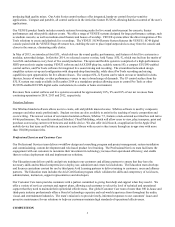Avid 2014 Annual Report Download - page 21
Download and view the complete annual report
Please find page 21 of the 2014 Avid annual report below. You can navigate through the pages in the report by either clicking on the pages listed below, or by using the keyword search tool below to find specific information within the annual report.15
We may not be able to achieve the efficiencies, savings and other benefits anticipated from our cost reduction, margin
improvement and other business optimization initiatives.
We are continually reviewing and implementing programs throughout the company to reduce costs, increase efficiencies and
enhance our business. We have in the past undertaken and expect to continue to undertake various restructuring activities and cost
reduction initiatives in an effort to better align our organizational structure and costs with our strategy. In connection with these
activities, we may experience a disruption in our ability to perform functions important to our strategy. Unexpected delays,
increased costs, challenges with adapting our internal control environment to a new organizational structure, inability to retain and
motivate employees or other challenges arising from these initiatives could adversely affect our ability to realize the anticipated
savings or other intended benefits of these activities and could have a material adverse impact on our financial condition and
operating results.
Our products may experience quality issues that could negatively impact our customer relationships, our market
reputation and our operating results.
Our software products, as is typical of sophisticated, complex software, occasionally include coding defects or errors (commonly
referred to as “bugs”), which in some cases may interfere with or impair a customer’s ability to operate or use the software.
Similarly, our hardware products could include design or manufacturing defects that could cause them to malfunction. Although
we employ quality control measures, those measures are not designed or intended to detect and remedy all defects. The time and
resources available to devote to quality control measures are, in part, dependent on other business considerations, such as meeting
customer expectations with respect to release schedules. Any product defects could result in loss of customers or revenues, delays
in revenue recognition, increased product returns, damage to our market reputation and significant warranty or other expense and
could have a material adverse impact on our financial condition and operating results.
Our intellectual property and trade secrets are valuable assets that may be subject to third-party infringement and
misappropriation.
As a technology company, our intellectual property and trade secrets are among our most valuable assets. Infringement or
misappropriation of these assets results in lost revenues to us and thereby ultimately reduces their value. We rely on a
combination of patent, copyright, trademark and trade secret laws, as well as confidentiality procedures, contractual provisions
and anti-piracy technology in certain of our products to protect our intellectual property and trade secrets. Most of these tools
require vigilant monitoring of competitor and other third-party activities and of end-user usage of our products to be effective.
These tools may not provide adequate protection in all instances, may be subject to circumvention, or may require a vigilance that
in some cases exceeds our capabilities or resources. Additionally, our business model is increasingly focused on software
products and as we offer more software products our revenues may be more vulnerable to loss through piracy, which could result
in revenue losses for us. While we may seek to engage with those potentially infringing our intellectual property to negotiate a
license for use, we also may seek legal recourse. The legal regimes of certain countries in which we operate may not protect our
intellectual property or trade secrets to the same extent as do the laws of the United States. Regardless of jurisdiction, assuming
legal protection exists and infringement or misappropriation is detected, any enforcement action that we may pursue could be
costly and time-consuming, the outcome will be uncertain, and the alleged offender in some cases may seek to have our
intellectual property rights invalidated. If we are unable to protect our intellectual property and trade secrets, our business could
be harmed.
Our results could be materially adversely affected if we are accused of, or found to be, infringing third parties’ intellectual
property rights.
Because of technological change in our industry, extensive and sometimes uncertain patent coverage, and the rapid issuance of
new patents, it is possible that certain of our products or business methods may infringe the patents or other intellectual property
rights of third parties. Companies in the technology industry own large numbers of patents, copyrights, trademarks and trade
secrets and frequently enter into litigation based on allegations of infringement or other violations of intellectual property rights.
Our technologies may not be able to withstand any third-party claims or rights against their use. We have received claims and are
subject to litigation alleging that we infringe patents owned by third parties and may in the future be the subject to such claims
and litigation. Regardless of the scope or validity of such patents or the merits of any patent claims by potential or actual
litigants, we could incur substantial costs in defending intellectual property claims and litigation, and such claims and litigation
could distract management’s attention from normal business operations. In addition, we provide indemnification provisions in
























